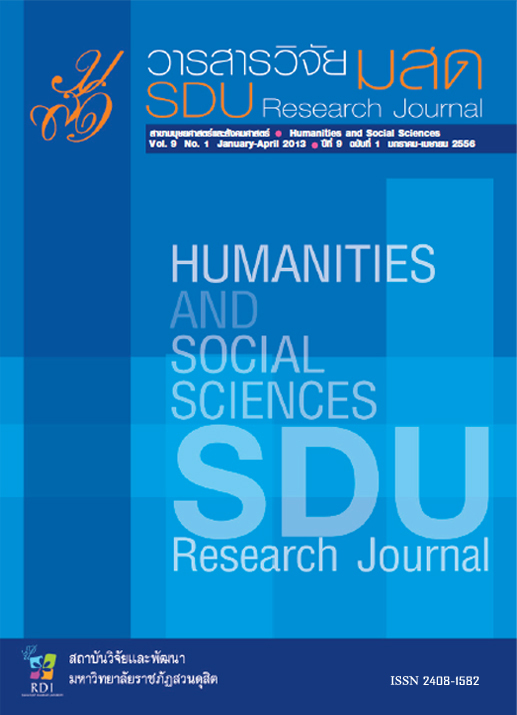แรงจูงใจในการออกกำลังกายของนักศึกษามหาวิทยาลัยราชภัฏกลุ่มรัตนโกสินทร์
Keywords:
แรงจูงใจ, การออกกำลังกาย, มหาวิทยาลัยราชภัฏกลุ่มรัตนโกสินทร์Abstract
บทคัดย่อ
การวิจัยครั้งนี้มีวัตถุประสงค์เพื่อศึกษาและเปรียบเทียบแรงจูงใจในการออกกำลังกายของนักศึกษามหาวิทยาลัยราชภัฏกลุ่มรัตนโกสินทร์ ในแต่ละมหาวิทยาลัยและแต่ละชั้นปี กลุ่มตัวอย่างเป็นนักศึกษาที่ศึกษาอยู่ในมหาวิทยาลัยราชภัฏกลุ่มรัตนโกสินทร์ ชั้นปีที่ 1-4 จำนวน 600 คน ผู้วิจัยใช้แบบสอบถามเป็นเครื่องมือในการเก็บรวบรวมข้อมูล สถิติที่ใช้ในการวิเคราะห์ข้อมูล ได้แก่ ความถี่ (frequency) ค่าร้อยละ (percentage) ค่าเฉลี่ย (mean) ส่วนเบี่ยงเบนมาตรฐาน (Standard Deviation S.D.) การวิเคราะห์ความแปรปรวนทางเดียว (one-way ANOVA) และการเปรียบเทียบความแตกต่างรายคู่โดยใช้วิธีของเชฟเฟ่ (Scheffe’s posthoc comparison)
ผลการวิเคราะห์ข้อมูล สรุปผลได้ดังนี้
แรงจูงใจในการออกกำลังกายของนักศึกษามหาวิทยาลัยราชภัฏกลุ่มรัตนโกสินทร์ โดยรวมอยู่ในระดับมาก
นักศึกษามหาวิทยาลัยราชภัฏกลุ่มรัตนโกสินทร์แต่ละมหาวิทยาลัยมีแรงจูงใจในการออกกำลังกายรวมทุกด้านแตกต่างกันอย่างมีนัยสำคัญทางสถิติที่ระดับ .05 และเมื่อพิจารณาเป็นรายด้าน พบว่าด้านเป้าหมาย ไม่แตกต่างกันอย่างมีนัยสำคัญทางสถิติที่ระดับ .05 ส่วนตัวความสนใจ ด้านความต้องการด้านเจตคติ ด้านการเรียนรู้เกี่ยวกับความก้าวหน้า และด้านสิ่งล่อใจ แตกต่างกันอย่างมีนัยสำคัญทางสถิติที่ระดับ .05
Abstract
This research study investigated and compared studentsû motivation for exercising in
Rajabhat Universities, Rattanakosin Group. Participants were 600 students studying in the
first, second, third, and fourth years. The research instrument was a questionnaire. Data
analysis employed descriptive statistics using frequency, percentage, mean and standard
deviation. The techniques of one-way analysis of variance (ANOVA) and Schefféûs post
hoc comparison method were also employed. Findings showed that: 1) overall, studentsû
motivation for exercising was at a high level; 2) it was statistically significant at the level of .05
regarding the overall motivation of the students in every university, including interest, needs,
attitudes, learning for improvement, and incentives when comparing in particular aspects but
it was not statistically significant concerning the goal aspect; and 3) finally, overall it was not
statistically significant regarding years of study. This included some particular aspects
relating interest, needs, attitudes, goal, and incentives. However, it was statistically significant
at the level of .05 concerning learning for improvement.
Keyword: Motivation, Exercising, Rajabhat Universities, Rattanakosin Group








